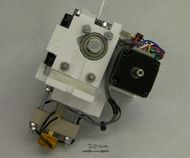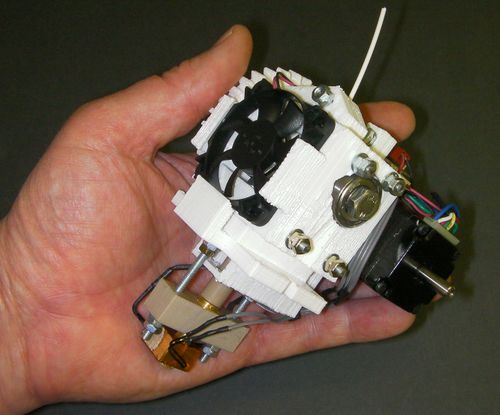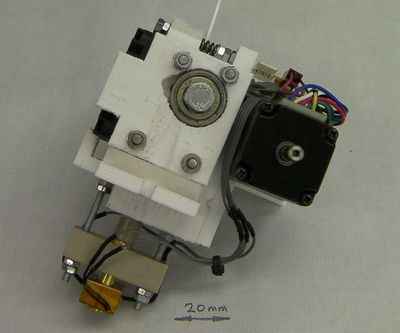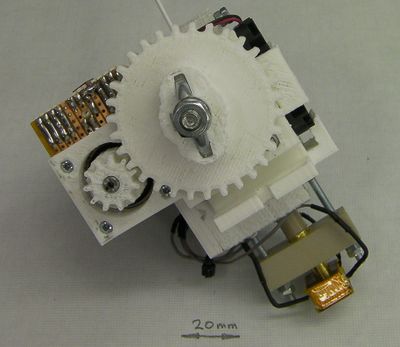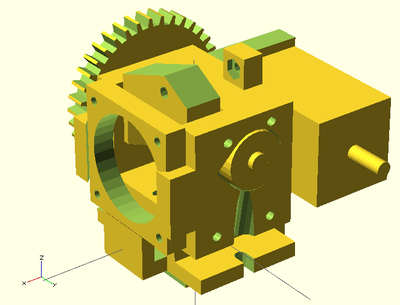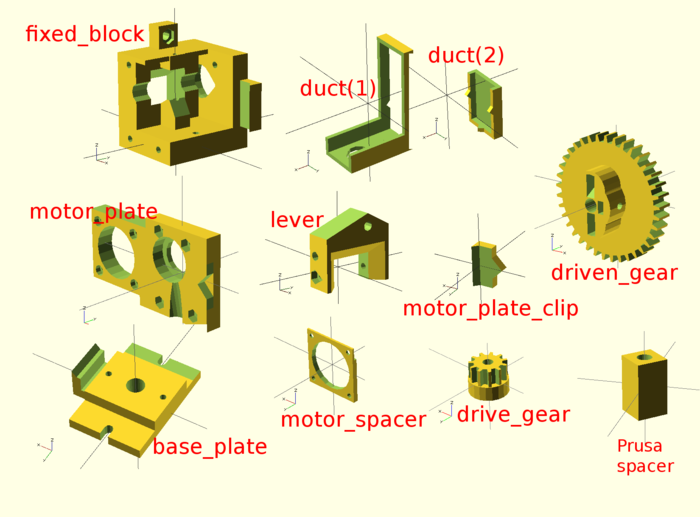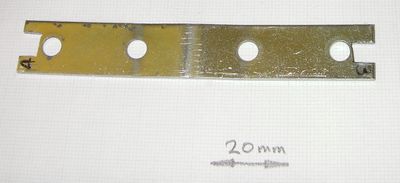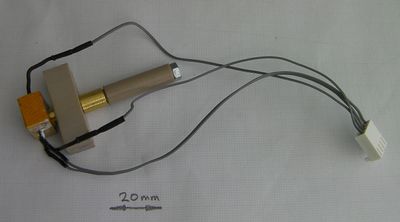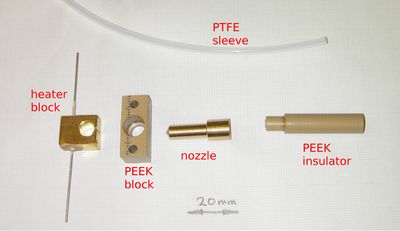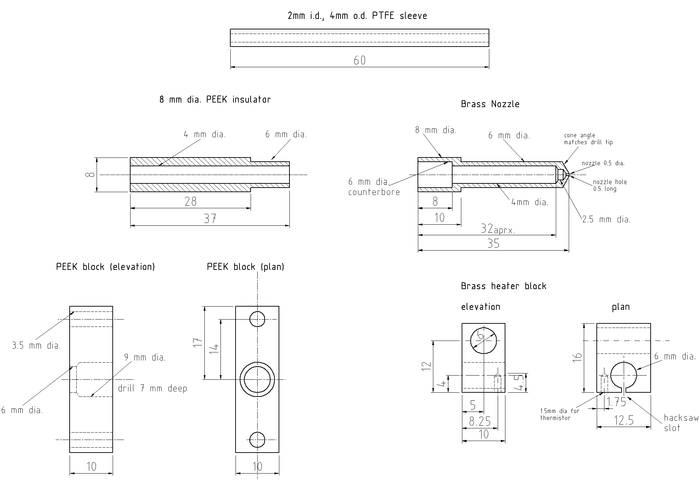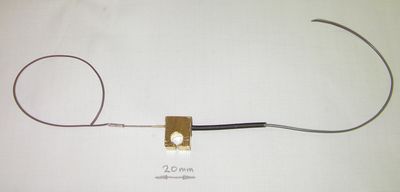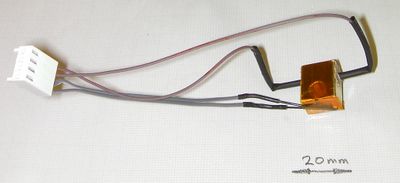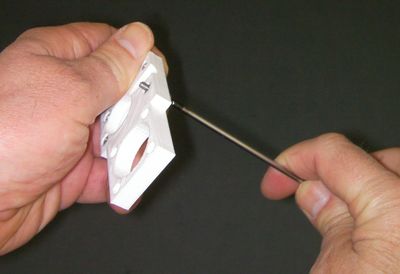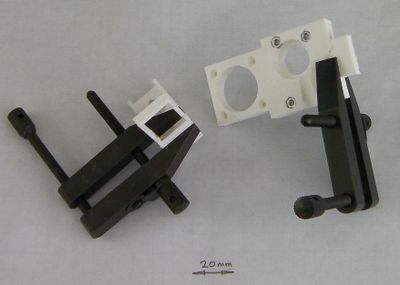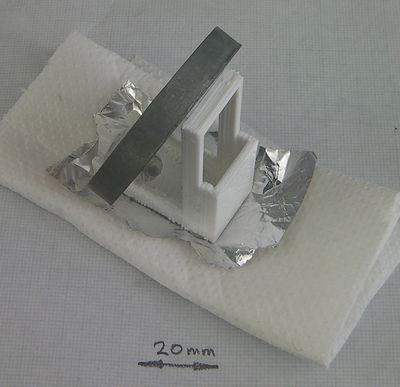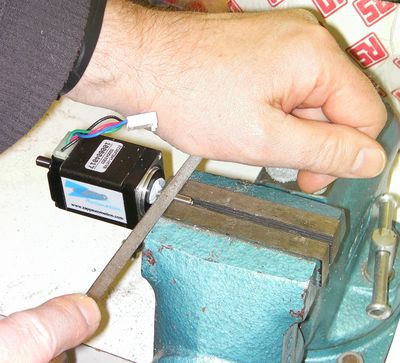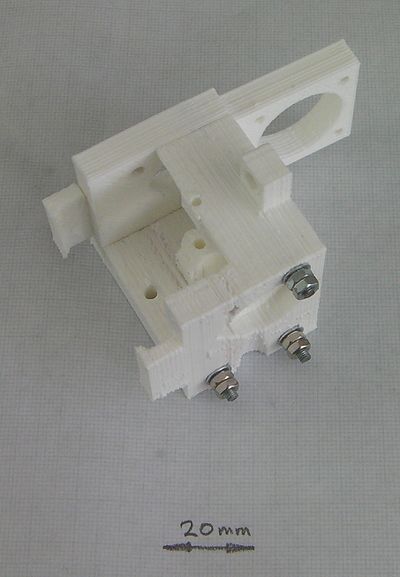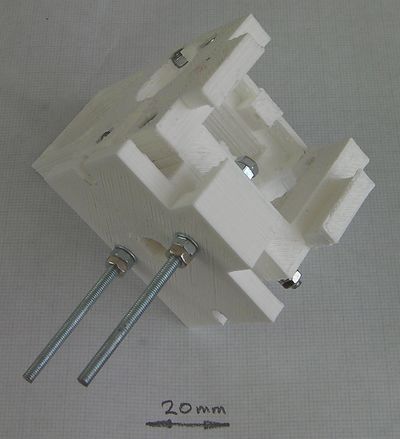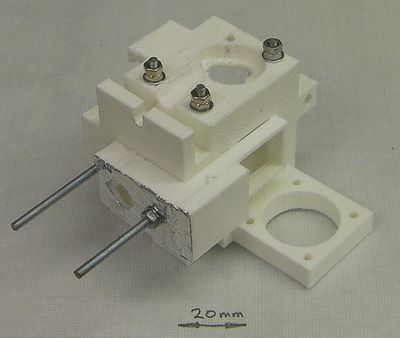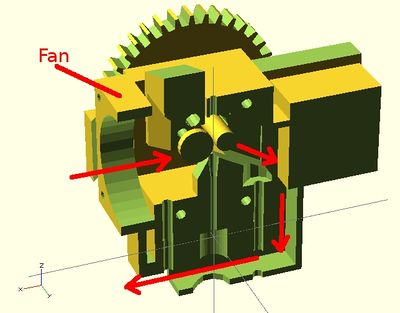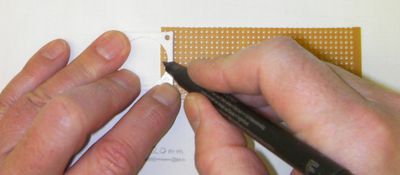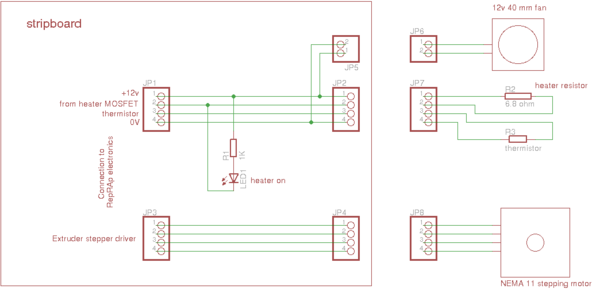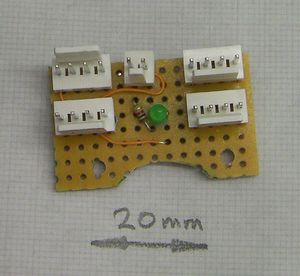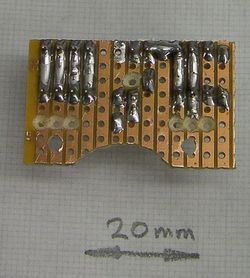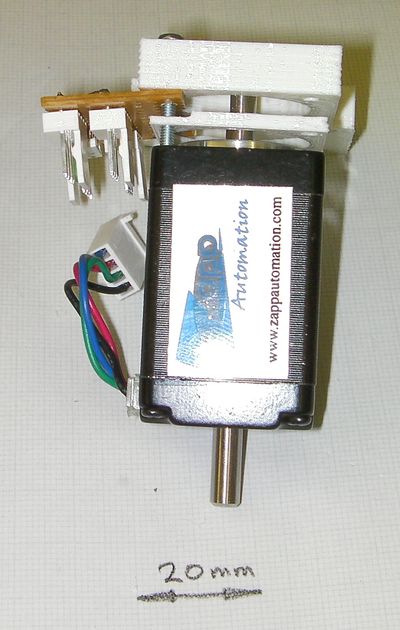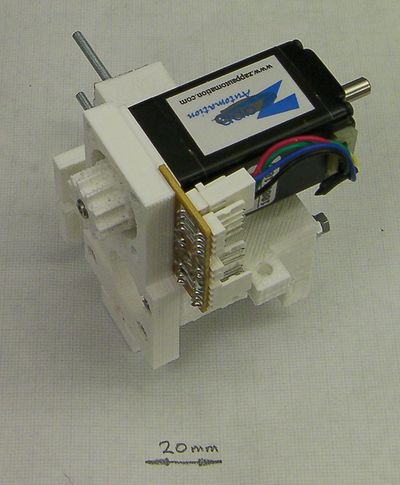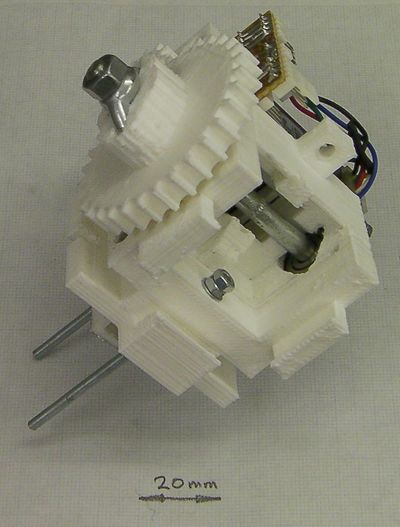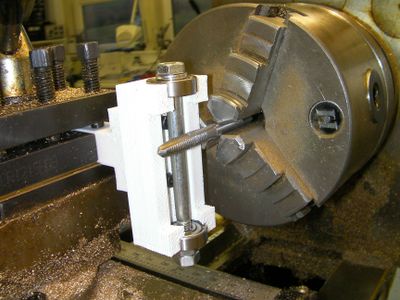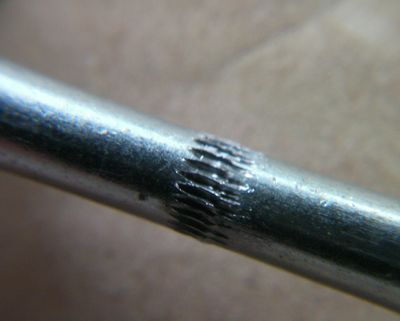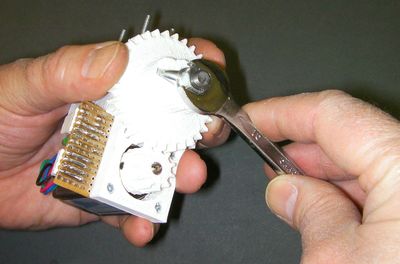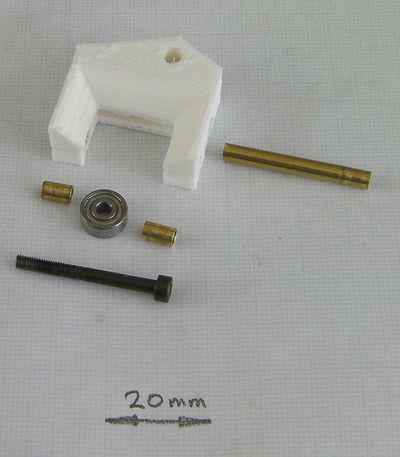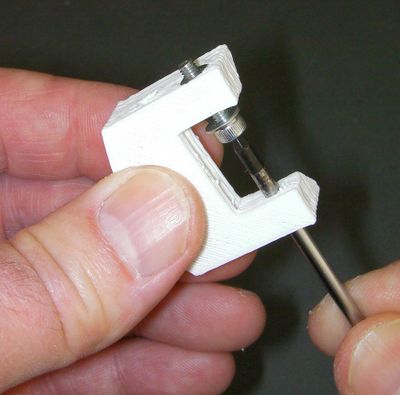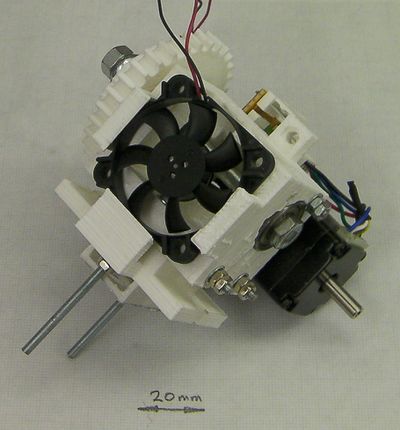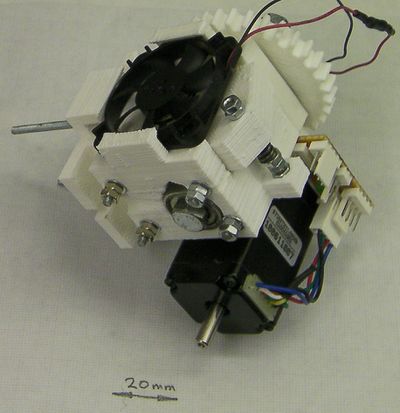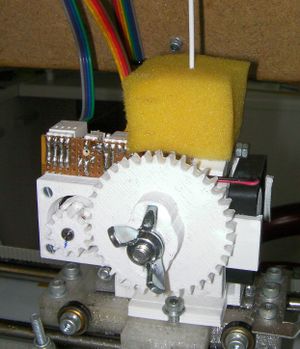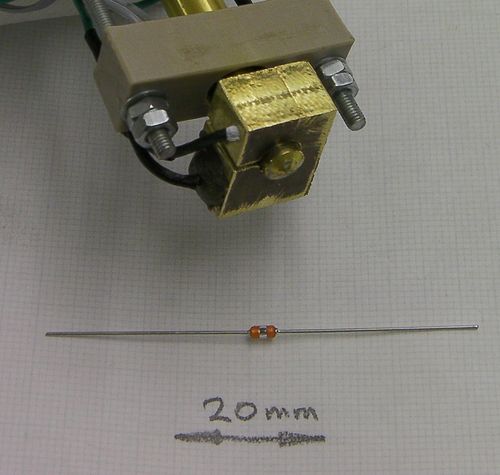RepRap Universal Mini Extruder
Release status: working
| Description | A small extruder for 1.75mm filament.
|
| License | GPL
|
| Author | |
| Contributors | |
| Based-on | [[]]
|
| Categories | |
| CAD Models | |
| External Link |
Contents
Introduction
This printable extruder is intended to work on RepRap Mendel, RepRap Huxley, and virtually any other open-source 3D printer you can find.
It features:
- 1.75 mm filament
- Adaptable mounting plate to attach it to virtually any 3D printer
- Very compact high-torque NEMA 11 motor
- Active ducted fan cooling for high reliability
- Wade-style hobbed bolt filament transport
- Wing-nut drive to spread the torque loading on the plastic gears
- Push-fit hot-end parts - no thread cutting
- Easily replaced PTFE liner for the hot end
- A single M3-threaded rod cut to lengths makes all the fixings
- Lightweight: 330g (about 50% the weight of this extruder)
- Compact design (110 mm x 90 mm x 80 mm)
I based this design (loosely) on Jstkatz's extruder on Thingiverse, in particular, the idea of using a lever to trap the filament against its drive.
Front view
Rear view
Bill of materials
All the design files for the extruder are on github here. The OpenSCAD models are in the file universal-1.75mm-filament-extruder.scad. You will also need the files library.scad, parameters.scad, Design-drawings/bearing180.dxf and Design-drawings/bearing360.dxf.
The (very simple) Eagle circuit diagram is in Design-drawings/extruder.sch and the drawings of the hot-end components are in Design-drawings/hot-end.dxf.
Here is the OpenSCAD rendering of the reprapped components. You will need one each of the above, except for the Prusa spacer. You won't need that for the standard Mendel, but you will need two for Prusa Mendel. The OpenSCAD design also contains two parts that form a bolt-hobbing jig. These are not part of the finished extruder, but will help you to make it.
The base-plate design shown above is for Mendel (both standard and Prusa, though Prusa needs two spacers as shown). It is easy to adapt for virtually any RepRap and RepRap-like machine, though. The only critical things from the extruder's perspective are the 8.5mm hole for the PEEK insulator, the two 3mm holes 28 mm apart for the tie-rods that retain the hot end, and the support clip for the fan. As long as those are in the right place and there is space for the air duct to pass through, just about all the rest of the plate can be anywhere, with fixing holes wherever you like. Any plate you design needs to be 11 mm thick for the duct to fit under it.
Here is the complete bill of materials:
| Item | Type | Quantity | Notes/sources |
| Fixed block | reprapped | 1 | |
| Duct 1 | reprapped | 1 | |
| Duct 2 | reprapped | 1 | |
| Motor plate | reprapped | 1 | |
| Lever | reprapped | 1 | |
| Motor plate clip | reprapped | 1 | |
| Driven gear | reprapped | 1 | |
| Base plate | reprapped | 1 | |
| Motor spacer | reprapped | 1 | |
| Drive gear | reprapped | 1 | |
| Prusa spacer | reprapped | 2 | Prusa Mendel only |
| NEMA 11 motor | electrical | 1 | http://www.zappautomation.co.uk/en/nema-11-stepper-motors/350-sy28sth45-0674b-high-torque-hybrid-stepper-motors.html |
| 12v 40mm 2-wire fan | electrical | 1 | ebay |
| 100 K glass bead thermistor | electrical | 1 | http://uk.rs-online.com/web/5288592.html |
| 6.8 ohm vitreous power resistor | electrical | 1 | http://uk.rs-online.com/web/0152280.html |
| 4-way pin header | electrical | 4 | |
| 2-way pin header | electrical | 1 | |
| 4-way header socket | electrical | 4 | |
| 2-way header socket | electrical | 1 | |
| 1k resistor | electrical | 1 | |
| 3mm LED | electrical | 1 | |
| 2.54mm stripboard | electrical | 13x8 holes | |
| bootlace ferrules | electrical | 2 | http://uk.rs-online.com/web/2114274.html |
| 2mm heatshrink sleeve | electrical | 150mm | |
| 8mm diameter PEEK rod | mechanical | 40mm | http://uk.rs-online.com/web/0514776.html |
| 10x10x34 PEEK block (3/8” thick is fine) | mechanical | 1 | |
| 10x16x12.5 brass block (3/8” thick is fine) | mechanical | 1 | |
| 8mm diameter brass rod | mechanical | 35mm | |
| 2mm internal dia. PTFE tube | mechanical | 60mm | http://www.adtech.co.uk/TubeSize2.html – PT2x4 |
| 7 mm long 3mm internal diameter brass tube | mechanical | 2 | http://www.gladstons.com/shop/176-round-brass-tube 5/32x0.014 |
| 33 mm long 3mm internal diameter brass tube | mechanical | 1 | http://www.gladstons.com/shop/176-round-brass-tube 5/32x0.014 |
| 80mm M6 bolt | mechanical | 1 | |
| M6 wing nut | mechanical | 2 | |
| M6 washer | mechanical | 1 | |
| 626 bearing 6x19x6 | mechanical | 2 | |
| 623 bearing 3x10x4 | mechanical | 1 | |
| spring - wire: 1mm, id: 4mm, L: 12mm | mechanical | 1 | |
| M4 nut | mechanical | 1 | |
| 30mm M3 cap screw | mechanical | 1 | |
| 10mm M3 grub/set screw | mechanical | 1 | |
| M3 threaded rod 40 mm long | mechanical | 1 | |
| M3 threaded rod 55 mm long | mechanical | 4 | |
| M3 threaded rod 80 mm long | mechanical | 2 | |
| 12mm M2.5 screws | mechanical | 4 | |
| M3 washers | mechanical | 13 | |
| M3 nuts | mechanical | 33 | |
| Car exhaust repair putty | mechanical | 1 ml | Fire cement works well too, but it can be a bit gritty |
| 12mm Kapton tape | mechanical | 100mm | |
| 15mm M4 cap screws | mechanical | 2 | For attaching to the Mendel X carriage |
| M4 washers | mechanical | 2 | For attaching to the Mendel X carriage |
10mm PEEK sheet costs silly money, but it tends to be sold in quite large sizes and you only want a very small piece. Lots of RepRap suppliers sell it in small quantities.
Make sure you get an M6 bolt, not a screw. On a bolt the thread only comes a short way up the shaft (20mm in this case); the rest is smooth.
The NEMA 11 motor that I used in the first version was this one, and that is what appears in the pictures below. But I have since tried the one in the Notes column of the Bill of Materials above. That works too, and it is smaller lighter and cheaper. If you can get one with a single shaft, that will be even more compact. There is no need to use the double-shaft one that I used.
The fan I used was 7mm thick. But some 40mm fans are 10mm thick. The OpenSCAD model for this extruder has the fan thickness as a parameter, so you can print the parts corresponding to your fan.
The PTFE in the BoM is longer than you need. This is to allow for trimming and mistakes.
The Hot end components can be bought from here.
A useful tool
Most of the nuts in this design are in pairs as double lock-nuts. You will need spanners, of course. But most spanners are thicker than the nuts they fit. You may find it useful to get an old bit of sheet steel the same thickness or thinner than a nut and cut your own spanner with a hacksaw and small file. I used a straightened-out shelf bracket - M3 nut size at one end, M4 at the other. For this extruder you only need the M3.
The hot end
Start by building the hot end.
The hot end has a brass nozzle with a brass heater block containing a 6.8 ohm heating resistor and a temperature sensing thermistor. The brass nozzle has a PEEK insulator inserted into its top, and a PEEK block. The block has two M3 threaded rods running through it. These attach the hot end to the rest of the extruder. A PTFE liner runs down the central hole in the device, stopping about 12 mm from the bottom. The last section is a melt chamber with no liner so that heat can conduct into the polymer more quickly.
Here is a picture of the hot-end components (you will also need the M4 nut), and...
... here are the drawings for them. You could almost certainly make the nozzle and block from aluminium rather than brass. But don't use two different metals: if you do thermal expansion will cause the heater block to work loose.
Start by making the PEEK block. This is pretty straightforward. To get the 7mm deep hole, I just mark 7 mm on the side of the drill flutes with a felt-tipped pen. That is, 7mm in from the point of the tip. Make sure you can see your mark when the drill spins...
You will see that the holes for the threaded rods are 3.5 mm in diameter, even though the rods are M3. You want them to be a lose fit.
Next make the heater block. I hacksawed this roughly from a 3/8" sheet of brass, which is 9.5mm thick, not 10. Then I filed it square and drilled the holes. Clamp the block in the drill vice and support it underneath with a sacrificial piece of wood - you don't want it twisting as you drill it. None of the dimensions are critical. Make the hacksaw split on the 6mm hole last of all, and file away any burrs from the edges.
Next turn the nozzle. Face off the ends, then mark the centre with the finest centre drill you can find. Drill the 0.5mm nozzle hole about 4 mm deep. Use a woodpecker cycle - every 0.5 mm or so withdraw the drill to clear the swarf. Take real care drilling this hole. 0.5mm drills are not strong...
Turn the cone on the end. Take this just far enough back to obliterate the centre-drill mark you made. Run a fine file over the outer edge of the cone to round it off. You will probably find that you have also obliterated the end of your 0.5mm hole. Open it up again by hand with the 0.5mm drill held in a pin chuck.
Turn down the 6mm shaft. As you near the right diameter keep stopping and check it repeatedly against the 6mm hole in the heater block. You want an interference fit - don't go to far.
Turn the nozzle round in the chuck, so it is held by that 6mm shaft. Turn down the 8mm end.
Mark the centre and drill the 6mm counterbored hole with an ordinary twist drill 8 mm deep.
Drill the 4mm hole. The depth of this is not critical - it needs to stop a few mm from the end. Obviously don't go too far. I find it easiest to put the drill beside the nozzle and mark the depth on the drill with a felt-tipped pen. Then I just drill to my mark.
If you have a 6mm slot drill, you can use that to finish the counterbore. If not, grind an old 6mm drill flat as described here and use that.
Take the nozzle out of the chuck and hold the 2.5mm drill beside it. By eye line the tip up so that it's about 0.5mm in from the nozzle tip. Mark the drill at the other end using the felt-tip again to coincide with the end of the 8mm section. Beware parallax. Look at what you have done, and make sure you remember the relation between your mark and where the drill will have to sink to. Put the drill in the tailstock and carefully drill to your mark. You will probably find that this has again blocked the 0.5mm hole. Holding the nozzle tip upwards (you want swarf to fall out of the big end) clear it by hand, as before. Twist a big drill by hand against the 6mm hole to chamfer the edge, again with the tip pointing up.
Finally make the PEEK insulator. Again, when turning the 6mm section, check it repeatedly against the 6mm hole in the nozzle. You want a tight fit that you can just push by hand. PEEK gets very hot with friction when machined, especially when drilled. Again use a woodpecker cycle for the 4mm hole, and give the drill and the PEEK plenty of time to cool between drilling.
Alternatively, if you are feeling adventurous, you can use the heat to do something subtle: drill the centre hole down the PEEK insulator from the reduced-diameter end to the top end in one shot. The drill will get hotter as it goes through, so the top of the PEEK will be drilled hotter than the bottom, and will expand. On cooling, the result is a very slight taper from a wide bottom to a narrow top. The PTFE liner will take up this profile under pressure in use. This makes filament jams almost impossible - the filament is being pushed from a narrow diameter to a wide one.
For the same reason try to make the 4mm hole in the brass slightly larger than that in the PEEK. At least make absolutely sure that it is no smaller.
Screw the M4 nut onto the end of the PTFE sleeve. You will find it easier to do this if you whittle a small cone on the end of the PTFE with a scalpel or, better, a pencil sharpener (don't cut too far). Screw the nut on so that a few mm of PTFE comes out the other side (completely clearing the cone), then cut that off flush with the nut with the scalpel.
Try putting a short piece of extruder filament down the nut end. Putting on the nut may have closed the tube too tight. If it has, gently twist a 2mm drill by hand into the end to restore the 2mm hole. Make sure you blow any swarf out of the sleeve.
Put the brass nozzle and the PEEK insulator together and place the PTFE beside them with the nut resting on the top end of the insulator. Cut the PTFE so that it is about 12mm up from the tip of the nozzle. This is where it will end inside the device; the continuing 4mm hole will form the melt chamber.
Retain the resistor inside the heater block with exhaust putty or fire cement. Make sure that whatever you use is rated up to 250o C. Don't cut the resistor leads - leave them full length. Crimp wires onto the ends of the resistor leads using bootlace ferrules or similar (shown left). Don't solder the wires - the solder won't stand the temperature.
Put heat shrink over the join (shown right). If you do this while the putty or cement are still unset, you can push the heatshrink a little way into it. When the cement is set and the heatshrink shrinks, this will make a very neat join. Don't bother to heat the heatshrink - when you operate the nozzle the heat will do this for you.
Solder two leads onto the thermistor. I put PTFE sleeving taken from PTFE-insulated wire on the thermistor leads themselves. If you do this, only take one leg's insulation right up to the thermistor; leave the other short by about 3 mm. If both pieces of insulation abut the thermistor, they will put a strain on its leads as they are a little to thick to fit in the gap. Alternatively you can use fine heat-shrink, but this won't be as flexible.
These pictures show a 4-way connector on the wires. That will be fitted later. Leave the wires long for now.
Wrap a 10mm square of PTFE plumber's tape round the thermistor itself, then insert it in its hole.
The picture shows the thermistor secured with Kapton tape wrapped round the block. But I have subsequently found that it is better to use a little more exhaust putty to retain the thermistor in its hole. Put some cement down the hole, and also dip the thermistor in the it. Push the thermistor into the hole and build up a little cement round the protruding PTFE-insulated leads to act as strain relief. Take care that neither thermistor lead shorts to the brass - check with a multimeter. Note that while exhaust putty is wet it is an electrical conductor so you won't get infinite resistance. But it should be a few tens of killohms, not a few ohms. If you have a short, wiggle the thermistor in the wet cement until it goes away.
Put the PEEK block on the brass nozzle, and then put on the heater block. If need be, stand the heater block on a short length of tube (15 mm plumbing pipe works well) and tap the nozzle through it with a soft hammer. You want a tight fit for good thermal contact. The tube is to stop the point of the nozzle getting damaged.
Push the PEEK insulator into the back, then gently push the PTFE sleeve down the device until the nut meets the top of the PEEK insulator.
Here's the lookup table for the thermistor for the firmware:
// RS thermistor 528-8592; EPCOS NTC G540
// ./createTemperatureLookup.py --r0=100000 --t0=25 --r1=0 --r2=4700 --beta=4036 --max-adc=1023
// r0: 100000
// t0: 25
// r1: 0
// r2: 4700
// beta: 4036
// max adc: 1023
#define NUMTEMPS 20
short temptable[NUMTEMPS][2] = {
{1, 864},
{54, 258},
{107, 211},
{160, 185},
{213, 168},
{266, 154},
{319, 143},
{372, 133},
{425, 125},
{478, 116},
{531, 109},
{584, 101},
{637, 94},
{690, 87},
{743, 79},
{796, 70},
{849, 61},
{902, 50},
{955, 34},
{1008, 2}
};
Assembly
Sink four M3 nuts in the holes in the motor plate. Use a short M3 screw and washer to pull them into place. Make sure the hexagons line up before you pull.
Offer up the clip to the motor plate, and the two halves of the duct to each other. Trim away any excess plastic with a blade to ensure a snug fit.
Arrange a couple of clamps to hold the parts while they set, glue them with superglue, and clamp them. The triangular lip of the clip points away from the nuts you just fitted in the motor plate (that is, it points away from the camera, into the grey table in the picture).
A piece of polythene plastic bag under the clamps will ensure that they don't glue to the work...
When the duct is set, glue aluminium kitchen foil onto the bottom of it. Weight it onto something soft to get the foil well pushed against the duct. The aluminium is a heat reflector. Cold air will be running on the interior of the duct, and the foil helps keep the whole thing cool from both the extruder hot end under it, and any heated bed that you may be using. When the glue is set, trim the foil round the edges and from the holes.
If your NEMA 11 motor has a round shaft, file a flat on it. Put Blu-tack into the gap between the motor shaft and the motor body to keep filings out of the motor's bearing. Fit the drive gear on the shaft so that the ends coincide, and note roughly where the flat needs to be. Take the gear off. Clamp the shaft (not the motor body) in a vice and file the flat. If you use a small file you can see when the flat is parallel with the shaft axis - it makes a rectangle. A trapezium means you've filed at an angle.
Put lock nuts on the ends of three of the 55 mm M3 threaded rods. Put washers under them and use them as long screws to attach the motor plate to the fixed block. Do them up firmly but not too tight - remember you're assembling a plastic object, not a steel one.
Put lock nuts on the end of one of the 80 mm M3 threaded rods. Put a washer under them and use this to attach the base plate to the fixed block at the side where the fan will go. Put two nuts and a washer on the bottom end, but don't do them up tight yet.
Push the other 80 mm M3 threaded rod up through the holes at the back where the diagonal air passage runs through the fixed block. Drop a washer over it and put two nuts on it. Lock them against each other at the top of the thread (this can be a bit fiddly - I used two pairs of long-nosed pliers). Run a washer and nuts up the other end from the bottom.
Tighten up the two rods.
Put the air duct over the second rod and secure it with two locked nuts (only one shown above) and a washer.
This shows an OpenSCAD cross section of the extruder with the path of the airflow.
Use the motor spacer as a template to mark out two 2.5mm drill holes and a circular dent in a piece of stripboard. The stripboard wants to be 13 holes by 8, with the strips going in the short direction - see below. Drill the holes and file away the circular dent.
Break the strip tracks as shown and solder on the connectors, the 1K resistor and the LED. You will also need to run a couple of fine insulated wires to connect one end of the LED and one end of the fan connector. Run solder along the motor and heater tracks as shown to get a good path for high current. Note the shorted tracks just to the right of the centre at the top.
Mark the end of the motor shaft with a felt-tipped pen so you can locate the flat you filed on it when that flat is under the drive gear.
Put an M3 nut in the slot in the drive gear and loosely put a 10mm M3 set/grub screw through it. Make sure that the grub screw does not yet poke into the 5mm motor shaft hole.
Put the drive gear on the stepping motor's shaft. Tighten the set screw to hold it firmly. Mark the gear next to your mark on the motor shaft. That way you will be able to see if it works lose after long usage.
Mount the NEMA 11 stepping motor, the stripboard, and the motor spacer to the motor plate with four 12mm M2.5 screws.
Cut the motor leads to length and put a 4-way socket on them. Allow a little slack, so you can plug and unplug the socket.
Put the 626 bearings in their holes either side of the extruder and put the 80 mm M6 bolt through them. Put a washer on the gear end.
This shows the sequence of components down the bolt. I used an M6 hex nut on the end, but another wing nut the other way round would be better - it will allow you to take the gear off and put it back on more easily. I'd recommend that (and it's in the bill of materials above). Unfortunately, there seems to be no standard for the sizes of wingnuts; if yours are a bit big, you may need to file their ears to make them fit in the gear...
Push the M6 wing nut into the top of the gear and screw both onto the bolt. When the gear engages with the motor you may find it simpler to turn the head end of the bolt than the gear. Put a lock nut on the wing-nut end.
Do everything up finger tight.
Push a short length of filament down through the extruder and mark either side of it on the bolt with a felt-tipped pen.
Dismantle the bolt, gear and associated components so you can hob the notches on the bolt that will drive the filament through the extruder.
The hobbing jig is designed to fit in the toolpost of a lathe, with an M5 tap in the lathe chuck to do the hobbing. But it should be possible to set things up with a clamp and a vice, and to do the hobbing with an electric drill instead.
Put two 30mm M3 cap screws through the slots in the hobbing jig and use them to attach the handle.
Carefully extend your filament marks on the bolt so they go right the way round.
Put the bearings and the bolt in the hobbing jig. Clamp the jig and offer the bolt up to the M5 tap. Measure how far out your felt-tip marks either side of the filament are from the centre-line of the tap.
Take everything apart and carefully slide the hobbing jig handle in its slots through that distance to get everything aligned. You may find it helps to measure from the original positions of the handle screws and make a mark where you want them to end up.
Put everything back together and tighten two M6 nuts on the bottom of the bolt to lock it. It should freely rotate in the bearings.
If you have it, smear some Trefolex cutting compound on the tap and the bolt where they will touch.
To do the hobbing you want the drill or the lathe on its slowest turning speed.
Move the bolt against the tap and let the tap turn the bolt. Move it in another small amount.
Each time you push the bolt against the tap, leave it for a while to cut freely. Don't be too timid about the depths of cut you make, or you will just wear the bolt away, rather than cutting notches in it.
You want to cut just deep enough that the root of the tap threads is just cutting the bolt. This will reduce the bolt diameter a tiny fraction there, but you don't want to make a big dent.
When you have finished you may find that you can't get the bearing on the bolt's head-end off past the hobbing. This doesn't matter - that just becomes the bearing at that end of the bolt in the finished extruder...
Clean any swarf and cutting compound thoroughly off the bolt. Put everything back together finger tight.
This picture shows the M6 lock nut being tightened with a spanner. Don't do this yet (you need to take the bolt assembly off again to attach your extruder to your RepRap). But - when you do - always tighten the nut by holding the big gear as shown above. That way the torque from the spanner is not transmitted to the rest of the extruder.
Next assemble the lever. You will need an M3 nut in addition to the parts shown above.
I found that the cleanest and most accurate way to cut the 3mm internal-diameter brass tube was to use a plumber's pipe cutter. This seems a bit of a sledgehammer against the nut of the tube, but it works well. But, if you do use a pipe cutter, it will reduce the end diameters slightly. Open them out again by running a 3mm drill down the tubes. Clean away any burrs with a file.
Put the nut in the end of the lever using the same technique that you used for the motor plate above. You should find that an M3 allen key fits down the opposite hole in the lever, as shown. Try the 30mm M3 cap screw. It must not project out the end when it has been tightened, otherwise it will stop the free movement of the lever. If it is a little too long, put an M3 nut on it then file off the screw's end. Unscrewing the nut will clean up the thread after filing.
Assemble the M3 screw, brass tubes and bearing. Push the longer brass tube through the 4mm hole in the lever.
Next attach the fan - you want it blowing into the extruder.. Cut the leads to length (again, leave a little slack for plugging and unplugging), and put a two-way socket on the ends. Get the polarity right: the fan's red lead is +12v, the black is ground.
Put the lever in its slot. Put two M3 nuts on the end of the final 55mm length of M3 threaded rod, put a washer under them, and use the result as a screw to pass through the long brass tube in the lever. Do this up firmly, but not so tight that you draw the sides of the extruder together and trap the lever.
The 40 mm M3 threaded rod is the screw-adjuster that applies pressure to the filament via the bearing on the lever.
The trick with getting this in place is to do the assembly through the little post at the motor side of the extruder. Put an M3 nut in this post and screw the 40 mm rod a little way into it. Push a washer, and then the spring, into the hole in the lever - it helps to put a spare M3 screw through from the other side temporarily.
Put two more nuts, then a washer, onto the 40 mm rod. Screw it right through, running all the nuts down it as you go and withdrawing your temporary guide screw, until it pokes about 6mm out the far side of the lever.
Put two lock nuts on that end and tighten them against each other. These are to give you something to hold to adjust the lever pressure.
Finally, put some filament through, and position the two middle nuts so that the spring is just relaxed. Lock them together.
Push the hot end into its hole, with the two M3 threaded rods running through the PEEK block. Put two washers on the M3 rods up against the PEEK, and gently tighten two nuts against them. Put two further lock nuts on them to hold them securely.
Cut the heater and thermistor wires to length and fit a 4-way socket on them.
Plug the heater and thermistor into their connector.
The extruder is now finished. As mentioned above, when you fix it to your RepRap you will have to take the big gear off to get the two 15mm M4 screws that hold the extruder's base plate to the RepRap's X carriage in place.
When you put the big gear back on don't forget to hold the big gear when you tighten the M6 nut against the wing nut to lock it.
<videoflash type="vimeo">22485769</videoflash>
Here's a video of the extruder working. It is, of course, printing itself...
Speeds and Temperatures
With 16-microstep stepper driver electronics I set the number of steps per millimetre of output filament extruded to 30 with an 0.5mm nozzle. This gives very good prints with a maximum deposition speed set to 2500 mm per minute. I set the dwell at the start of extrusion to 50 ms. I expect that the extruder would work faster, though I haven't tried it, as I'm more concerned with quality than speed.
I reverse the extruder for 50mm of extruded-length at a speed of 18,000 mm per minute at the ends of runs to prevent dribble. At the start of the next run, I first go forwards to restore that retraction at 18,000 mm per minute, then slow to 2500 mm per minute, plot 50 milliseconds without moving, then start plotting. For the very first run in a new layer I increase that 50 ms dwell to 500 ms.
For PLA I run this extruder at 205oC.
Maintenance
Lightly grease the gears with silicone grease.
To put filament in the extruder for the first time, just run it down through and then tighten the lever adjuster. Tighten it about five turns after the bearing just touches the filament.
Renew the filament supply when the extruder is hot. Slacken off the lever, then pull out the old filament. Push the new filament in and tighten the lever as above.
Don't let the filament run out and disappear right down into the extruder - you'll have to take the whole thing apart to put new filament in...
Occasionally take the M6 bolt out and check it. It should be clean. If there is filament powder on the hobbed grooves then the device is slipping and abrading the filament. This means you need to run it slower. That is to say, use fewer mm/minute when building, or set the steps/mm value lower. The former will give slower results that look the same; the latter will give results at the same speed, but that have thinner filament making them. Another cause of this fault is having too thin a first layer (i.e. your Z zero is off); if the extruder has to push against a very thin gap the back pressure can damage the PTFE liner and also cause the drive to slip.
Filament gets dusty, especially as it is easily electrostatically charged. It is a good idea to run it through a cleaner. Use a reasonably chunky piece of bathroom sponge with a slit about 10mm long cut in it for the filament to run through. This just rests on top of the extruder in operation. If you use a hole rather than a slit, or you make the piece too small, you will find that the filament tends to drag it down the hole. Make sure it can't foul the gear.
PTFE is low friction, and good against temperature, but it is not all that strong. The liner will fail eventually, and the extruder has been designed to make it easy to swap. The symptom of failure is a slowing of the achievable flow rate.
To change the liner: Cut the filament going into the extruder about 50mm above the top. Slacken off the lever. Unplug the hot end, undo the four locked M3 nuts that hold it on, and remove it from the rest of the extruder together with the filament. Rest the hot end on a block of wood, or something else that will resist the heat, plug it into your RepRap, and run it up to about two-thirds the normal operating temperature - for PLA this is around 150oC. Let it cool. When it gets below 100oC hold the hot end with a pair of pliers and pull out the filament. It should all come out, as it is cool enough to withstand a certain amount of tension.
Take the PTFE sleeve out and examine it. If it is damaged, replace it.
Alternatives and improvements
This is the place to add alternatives and improvements to this design.
Alternate block and thermistor
The thermistor specified above works well, but it is rather delicate. This type (from RS here) is more robust, and can be easily accommodated as shown in the photograph.
The block needs to be a little larger (13.5mm x 19mm in plan; same thickness) and, as you can see, the slot runs out the side. Drill a 2mm hole for the thermistor right through. The leads come straight out either side (though you can only see the left end on the photograph).
Use bootlace ferrules to secure wires to the ends of the thermistor leads. Put thin heatshrink on the leads over the ferrules, and wrap the thermistor itself in a little PTFE plumber's tape. It can sit in the hole by friction - there's no need to cement it in place. Bend the leads so they run neatly a few millimeters away from the block.
Here's the look-up table for that thermistor for the firmware:
// Thermistor lookup table for RS thermistor 198-961
// Made with createTemperatureLookup.py (http://svn.reprap.org/trunk/reprap/firmware/Arduino/utilities/createTemperatureLookup.py)
// ./createTemperatureLookup.py --r0=100000 --t0=25 --r1=0 --r2=4700 --beta=3960 --max-adc=1023
// r0: 100000
// t0: 25
// r1: 0
// r2: 4700
// beta: 3960
// max adc: 1023
#define NUMTEMPS 20
short temptable[NUMTEMPS][2] = {
{1, 929},
{54, 266},
{107, 217},
{160, 190},
{213, 172},
{266, 158},
{319, 146},
{372, 136},
{425, 127},
{478, 119},
{531, 111},
{584, 103},
{637, 96},
{690, 88},
{743, 80},
{796, 71},
{849, 62},
{902, 50},
{955, 34},
{1008, 2}
};
